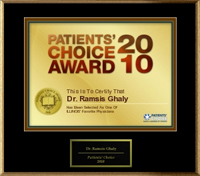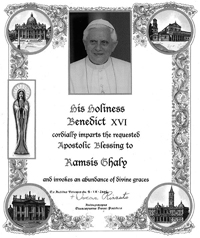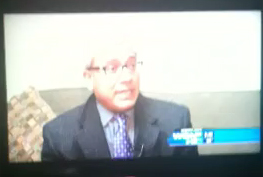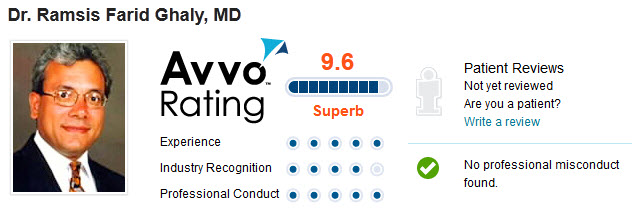Dr. Ramsis Ghaly Services
- General Neurosurgeon
- Interventional Pain Management
- Second Opinion
- Virtual Record Review
Social Media Links for reference:
- Facebook: https://www.facebook.com/ghalyneurosurgeon/
- LinkedIn: https://www.linkedin.com/in/ramsis-ghaly-70921343/
Directory Listings with Reviews & Other links:
- Rate MD: https://www.ratemds.com/doctor-ratings/2261678/Dr-RAMSIS-GHALY-AURORA-IL.html/
- Web MD: https://doctor.webmd.com/doctor/ramsis-ghaly-4ba3a8e0-e5c7-4811-8555-59241e3b71eb-overview
- Vitals MD: https://www.vitals.com/doctors/Dr_Ramsis_Ghaly.html
- Sharecare: https://www.sharecare.com/doctor/dr-ramsis-f-ghaly
- https://www.healthgrades.com/physician/dr-ramsis-ghaly-ytgdx
- US News: https://health.usnews.com/doctors/ramsis-ghaly-143499
- Yelp: https://www.yelp.com/biz/ghaly-neurosurgical-associates-aurora
- https://www.doximity.com/pub/ramsis-ghaly-md
- https://www.sjhsyr.org/provider/nasri-ghaly-md-neurology
Amazon Books:
Patients Quotes
Laurie Kapsalis
You're the real deal doc, brains, good looks and talent too!
Jack Jane Duvick
So happy for him and so proud to call you my doctor and friend!!!
Brenda Dickerson
Dr Ghaly, you are Blessed. Such skill and talent is God given. Thank you for all the miracles that you assist in.
Read More...
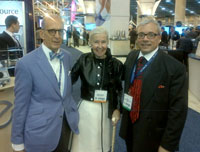
My Neurosurgeon Mentor, Dr James Ausman

Ghaly Foundation for
Neuroscience Care
Neurohealth Seminar since 2001 to present
Brain & Spine Neurosurgeon & Carpal Tunnel Surgeon
| Click image to view/download brochure | |
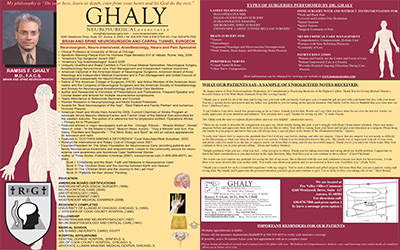 |
|
 |
|
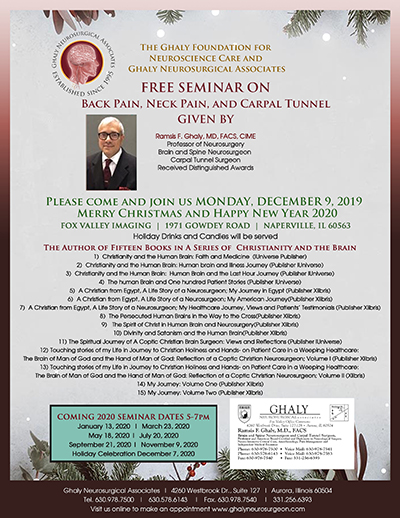 |
|
Ghaly Top Grade According to All the Reputable Searches Nationwide
One of my patients today came and surprised me with news that I wasn’t aware of and shared it with me! Thank you, Sabrina, my new patient!!
It is not me but my Lord Jesus and all my patients. The strength of our Christianity ✝️ laboring hand in hand with our Lord Jesus, reaching out to His children and caring night and day for their wellbeing. My patients are my cause and purpose in life until the end of my calling. Thank you 🙏 to all my patients that trusted my service and my God that accepted my lowliness!
Dr. Ghaly Top Doctor awarded HONORABLE Grade A in patient’s Outcome, Quality Patient’s Care, and Patient’s Satisfaction in all Reviews
Hospital Safety Grade
Healthgrades
Provider Finder Online
| Open Forum on Neurosurgical Topics |
Purity of the Mind & Heart
Religious - showing belief, devout, godly devotional
Affectionate - displaying warmth, softhearted
Miraculous - divine intervention
Sincere - open and genuine
Invaluable - serviceable, precious, priceless
Savior - a person who rescues you from harm
Faith - belief in god, code of ethics, standards of merit
Generous - willing to give and share
Humanitarian - charitable, merciful, compassionate
Attentive - mindful, courteous, observant
Loving - kindness, devoted, amorous
Yearn - to be moved or attracted, to feel tenderness
SURGERY PROCEDURES DONE BY DR RAMSIS GHALY, NEUROSURGEON
| LATEST TECHNOLOGY: | SPINE SURGERY WITH AND WITHOUT INSTRUMENTATION FOR: |
|
|
| BRAIN SURGERY FOR: | NEURO CRITICAL CARE MANAGEMENT |
|
|
| PERIPHERAL NERVES | PATIENT EDUCATION |
|
|
NEUROSURGEON
Neurosurgeon is a surgeon of the nervous system and the medical specialty concerned with the prevention, diagnosis, treatment and rehabilitation of disorders that affect the entire nervous system including the brain, spinal column, spinal cord, peripheral nerves, and extra-cranial cerebrovascular system.
In the United States, a neurosurgeon must generally complete four years of college, four years of medical school and 7 years of postgraduate training basic science and clinical aspects of CNS. Microsurgery is utilized in many aspects of neurological surgery. The clipping of aneurysms is performed using a microscope. Procedures such as resection of tumors, microdiscectomy, and laminectomy rely on the technique. Spinal instrumentation and fusion to stabilize or reconstruct the spine is a common procedure performed by a neurosurgeon.
Minimally invasive endoscopic surgery is utilized by neurosurgeons. Techniques such as endoscopic endonasal surgery are used for pituitary tumors, craniopharyngiomas, chordomas, and the repair of cerebrospinal fluid leaks. Ventricular endoscopy is used for colloid cysts and neurocysticercosis. Endoscopic techniques can be used to assist in the evaculation of hematomas and trigeminal neuralgia. Repair of craniofacial disorders and disturbance of cerebrospinal fluid circulation is done by neurosurgeons, and depending on the situation, plastic surgeons. Conditions such as chiari malformation, craniosynostosis, and syringomyelia are treated. This is called cranioplasty. Minimally invasive spine surgery utilizes relies on these techniques. Some neurosurgical procedures involve the use of MRI and functional MRI intraoperatively.
Neurosurgeons are involved in Stereotactic Radiosurgery along with Radiation Oncologists for tumor and AVM treatment. Radiosurgical methods such as Gamma knife and Cyberknife are used. Neurosurgeons have begun to utilize endovascular image guided procedures for the treatment of aneurysms, AVMs, carotid stenosis, strokes, and spinal malformations, and vasospasms. Also, nonvascular procedures such as Vertoplasty and Kyphoplasty are used by neurosurgeons. Techniques such as angioplasty, stenting, clot retrieval, embolization, and diagnostic angiography are utilized. Other conditions treated by neurosurgeons include:
- Spinal disc herniation
- Cervical spinal stenosis and Lumbar spinal stenosis
- Hydrocephalus
- Head trauma (brain hemorrhages, skull fractures, etc.)
- Spinal cord trauma
- Traumatic injuries of peripheral nerves
- Infections
- Tumours of the spine, spinal cord and peripheral nerves
- Intracerebral hemorrhage, such as subarachnoid hemorrhage, intraparenchymal, and intraventricular hemorrhages
- Some forms of drug-resistant epilepsy
- Some forms of movement disorders (advanced Parkinson's disease, chorea) - this involves the use of specially developed minimally invasive stereotactic techniques (functional, stereotactic neurosurgery) such as ablative surgery and deep brain stimulation surgery
- Intractable pain of cancer or trauma patients and cranial/peripheral nerve pain
- Some forms of intractable psychiatric disorders
- Vascular malformations (i.e., arteriovenous malformations, venous angiomas, cavernous angiomas, capillary telangectasias) of the brain and spinal cord
- Peripheral neuropathies such as carpal tunnel syndrome and ulnar neuropathy
- Moyamoya disease
SCIATICA
Sciatica (or sciatic neuritis) is a set of symptoms including pain that may be caused by general compression and/or irritation of one of five spinal nerve roots that give rise to each sciatic nerve, or by compression or irritation of the left or right or both sciatic nerves. The pain is felt in the lower back, buttock, and/or various parts of the leg and foot. In addition to pain, which is sometimes severe, there may be numbness, muscular weakness, pins and needles or tingling and difficulty in moving or controlling the leg. Typically, the symptoms are only felt on one side of the body. Although sciatica is a relatively common form of low back pain and leg pain, the true meaning of the term is often misunderstood. Causes of sciatica include the following: spinal disc herniation, spinal stensosis, piriformis syndrome, facet syndrome. Sciatica is generally caused by the compression of lumbar nerves L4 or L5 or sacral nerves S1, S2 or S3, or by compression of the sciatic nerve itself. When sciatica is caused by compression of a dorsal nerve root (radix) it is considered a lumbar radiculopathy (or radiculitis when accompanied with an inflammatory response) from a spinal disk bulge or spinal disc herniation (a herniated intervertebral disc in the spine), or from roughening, enlarging, and/or misaligning of the vertebrae (spondylolisthesis), or degenerated discs. The intervertebral discs consist of an annulus fibrosus which forms a ring surrounding the inner nucleus pulposus. When there is a tear in the annulus fibrosis, the nucleus pulposus (pulp) may protrude through and push against spinal nerves within the spinal cord or those exiting, causing numbness or excruciating pain. Sciatica due to compression of a nerve root is one of the most common forms of radiculopathy. Treatment may include "conservative and preventive" and spine surgery such as spinal.
One of the possible causes of sciatica is a spinal disc herniation pressing on one of the sciatic nerve roots. The spinal discs are composed of a tough spongiform ring of cartilage (annulus fibrosus) with a more malleable center (nucleus pulposis). The discs separate the vertebrae, thereby allowing room for the nerve roots to properly exit through the spaces between the L4, L5, and sacral vertebrae. The discs cushion the spine from compressive forces, but are weak to pressure applied during rotational movements. That is why a person who bends to one side, at a bad angle to pick something up, may more likely herniate a spinal disc than a person jumping from a ladder and landing on his or her feet.
Herniation of a disc occurs when the liquid center of the disc bulges outwards, tearing the external ring of fibers, extrudes into the spinal canal, and compresses a nerve root against the lamina or pedicle of a vertebra, thus causing sciatica. This extruded liquid from the nucleus pulposus may cause inflammation and swelling of surrounding tissue which may cause further compression of the nerve root in the confined space in the spinal canal.
Sciatica caused by pressure from a disc herniation and swelling of surrounding tissue can spontaneously subside if the tear in the disc heals and pulposis extrusion and inflammation cease.
Sciatica can be caused by tumours impinging on the spinal cord or the nerve roots. Severe back pain extending to the hips and feet, loss of bladder or bowel control, or muscle weakness, may result from spinal tumours. Trauma to the spine, such as from a car accident, may also lead to sciatica.
Other compressive spinal causes include lumbar spinal stenosis, a condition in which the spinal canal (the spaces through which the spinal cord runs) narrows and compresses the spinal cord, cauda equina, and/or sciatic nerve roots. This narrowing can be caused by bone spurs, spondylolisthesis, inflammation, or herniated disc which decreases available space for the spinal cord, thus pinching and irritating nerves from the spinal cord that travel to the sciatic nerves.
MIGRAINE
Migraine is a debilitating condition characterized by moderate to severe headaches, and nausea, about 3 times more common in women than in men. The typical migraine headache is unilateral pain (affecting one half of the head) and pulsating in nature, lasting from 4 to 72 hours; symptoms include nausea, vomiting, photophobia (increased sensitivity to light), phonophobia (increased sensitivity to sound), and is aggravated by routine activity. Approximately one-third of people who suffer from migraine headaches perceive an aura-unusual visual, olfactory, or other sensory experiences that are a sign that the migraine will soon occur. Treatment is with analgesics for the headache, an antiemetic for the nausea, and the avoidance of triggering conditions. The cause of migraine headache is unknown; the most common theory is a disorder of the serotonergic control system. A neurosurgeon may get involved in treatment of "migraine like headache" when MRI is showing surgical lesions such as brain tumors, brain arterivenous malformation, hydrocephallus, arnold chiarri malformation and cervical spine diseases. The headache usually associated with other neurological complaints. The surgery is directed toward the underlying cause.
CARPAL TUNNEL SYNDROME
Carpal Tunnel Syndrome (CTS) is idiopathic median neuropathy at the carpal tunnel. The pathophysiology is not completely understood but can be considered compression of the median nerve traveling through the carpal tunnel. The risk factors for CTS are primarily genetic rather than environmental.[2]
The main symptom of CTS is intermittent numbness of the thumb, index, long and radial half of the ring finger. The numbness usually occurs at night because we tend to sleep with our wrists flexed and is relieved by wearing a wrist splint that prevents flexion. Long-standing CTS leads to permanent nerve damage with constant numbness, atrophy of some of the muscles of the thenar eminence, and weakness of palmar abduction. Carpal Tunnel Syndrome is considered by some to be a form of repetitive stress injury, and as such, is caused by repetitive motions, most famously from long hours of computer keyboard use. However, while studies have found associations between some work activities and Carpal Tunnel Syndrome, causality has not been demonstrated. Treatment may include occupational therapy, education and prevention, medications, cortisone injection and surgery. Carpal tunnel surgery may be "open" or "endoscopic technique. Generally accepted treatments, as described below, may include splinting or bracing, steroid injection, activity modification, physiotherapy (preferable), regular massage therapy treatments, chiropractic, medications, and surgical release of the transverse carpal ligament. Early carpal tunnel surgery release is indicated where there is clinical evidence of median nerve denervation or the patient elects to proceed directly to surgical treatment. Carpal tunnel syndrome is found in association with the following conditions: diabetes mellitus, coexistent cervical radiculopathy, hypothyroidism, polyneuropathy, pregnancy, rheumatoid arthritis, and carpal tunnel syndrome in the workplace.
Release of the transverse carpal ligament is known as "carpal tunnel release" surgery. The goal is to divide the transverse carpal ligament in two. This is a wide ligament that runs across the hand, from the scaphoid bone to the hamate bone and pisiform. It forms the roof of the carpal tunnel, and when the surgeon cuts across it (i.e., in a line with the ring finger) it no longer presses down on the nerve inside, relieving the pressure. The two major types of surgery are open carpal tunnel release and endoscopic carpal tunnel release. Open surgery involves an incision on the palm about an inch or two in length. Through this incision, the skin and subcutaneous tissue is divided, followed by the palmar fascia, and ultimately the transverse carpal ligament. Endoscopic techniques involve one or two smaller incisions (less than half inch each) through which instrumentation is introduced including a synovial elevator, probes, knives, and an endoscope used to visualize the underside of the transverse carpal ligament. The endoscopic methods do not divide the subcutaneous tissues or the palmar fascia to the same degree as the open method does. It avoids scar and pain over the palm and provides faster recovery.
CHRONIC PAIN MANAGMENT
Chronic pain is "pain that extends beyond the expected period of healing. Chronic pain may be divided into "nociceptive" (caused by activation of nociceptors), and "neuropathic" (caused by damage to or malfunction of the nervous system). Nociceptive pain may be divided into "superficial somatic" and "deep", and deep pain into "deep somatic" and "visceral". Neuropathic pain is divided into "peripheral" (originating in the peripheral nervous system) and "central" (originiting in the brain or spinal cord). Pain management (also called pain medicine) is that branch of medicine employing an interdisciplinary approach to the relief of pain and improvement in the quality of life of those living with pain. The typical pain management team includes medical practitioners, clinical psychologists, physiotherapists, occupational therapists, and nurse practitioners. Acute pain usually resolves with the efforts of one practitioner; however, the management of chronic pain frequently requires the coordinated efforts of the treatment team. Conditions related to pain: Arthritis, Back pain, Cancer, Complex pain syndrome, Headache, Irritable Bowel Syndrome, Myofascial Pain Syndrome, Sciatica, Lumbar spinal stenosis and cervical spinal stenosis. Drugs may include non-opoids such as : Gabapentin, Pregabalin, Levetiracetam, Topiramate, Antidepressants, Local anesthetics, Acetaminophen (Paracetamol), NSAIDs and opoids. Surgery can be corrective to treat the cause such as spinal discectomy for spinal herniation of disc, laminectomy for spinal stenosis, lumbar fusion for unstable spine, microvacular decompression for trigeminal neuralgia or palliative such as Spinal cord stimulation and. Intrathecal delivery system.
AREAS SERVED
Over the years, most patients treated by Ghaly Neurosurgical Associates came from Aurora, Joliet, Oswego, Sandwich, Sycamore, DeKalb, Warrenville, Winfield, Geneva, Bloomingdale, Blomington, glen Ellyn, Lombard, Rockford, Bolingbrook, Lockport, Morris, Minooka, Bourbonnais, New Lenox, Frankfort, Orland park, Tinley park, Oak Lawn, Lemont, Oak Brook, Yorkville, Plainfield, Braidwood, Naperville, Palos Park, Chicago and greater Chicago metropolitan region, Illinois and out of state.
COUNTIES
Grundy, Kankakee, Will, DuPage, Livingston, Kane, LaSalle, Kendall
COUNTRY
USA
HOSPITAL AFFLIATIONS
JST of Cook County hospital, Chicago, Illinois
Central DuPage hospital, Winfield, Illinois


